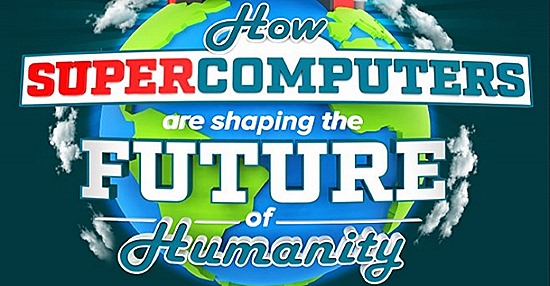
Supercomputers Are Shaping Future of Humanity
By KeriLynn Engel, Who Is Hosting This, 12 August 2016.
By KeriLynn Engel, Who Is Hosting This, 12 August 2016.
Humanity has come a long way. Our world today is full of technology and wonders we thought were the realm of science fiction not too long ago.
Our technological development is exponential. It was just a few hundred years ago that we started exploring the possibilities of electricity, and it didn’t become common in households till the early 20th century. Just a few decades later, we sent astronauts to the moon.
Yet even with all the progress we’ve made, we still have serious issues we haven’t been able to address: world hunger, the lack of clean drinking water for everyone, diseases like cancer, and natural disasters that take lives and destroy food supplies.
But we’re approaching an era where technology may be able to help solve these problems, using supercomputers.
Supercomputers are massively powerful and incredibly expensive computers. They use massive amounts of energy, take up a huge amount of space, and require thousands of gallons of water every minute to regulate their temperatures. A supercomputer is typically developed for a single purpose, and often requires special customized software in order to do its job.
Supercomputers have been around for a long time. The first supercomputer, the CDC 6600, was developed in 1964 and used to analyze various experiments conducted at CERN (the European Organization for Nuclear Research). The CDC 6600 was the world’s fastest computer from 1964 to 1969.
Since that time, supercomputers have been used for things like weather forecasting, climate research, oil and gas exploration, molecular modeling, cryptanalysis, and more.
And in the near future, they may be put to work to surmount those seemingly unsolvable problems: helping to develop sustainable systems like extracting drinkable water from different sources, more accurately predicting the weather so we can save lives and optimize our agriculture to grow more food, and even developing individualized medical treatments.
What exactly are supercomputers, how do they work, and how will they change our future? Check out the graphic below to find out.
Infographic Sources:
1. What is supercomputer?
2. What can you do with a supercomputer?
3. What is teraflop?
4. What is petaflop?
5. “No Exascale for You!” An Interview with Berkeley Lab’s Horst Simon
6. Fujitsu to design Japanese exascale supercomputer (IT World)
7. CPU - Central Processing Unit
8. GPU - graphics processing unit
9. Linux dominates supercomputers as never before
10. The TOP500 project
11. China’s Tianhe-2 Supercomputer Maintains Top Spot on List of World’s Top Supercomputers
12. Tianhe-2
13. Fujitsu to design Japanese exascale supercomputer (PC World)
14. Details Emerging on Japan’s Future Exascale System
15. Multi-Toroidal Interconnects (PDF)
16. Supercomputers’ Computational Capabilities to Save the World from Water Shortages!
17. Responding to Environmental Issues
18. Met Office to build £97m supercomputer
19. D-Day: The most important weather forecast in history
20. Phoenix Children’s getting supercomputer to improve genomic testing
1. What is supercomputer?
2. What can you do with a supercomputer?
3. What is teraflop?
4. What is petaflop?
5. “No Exascale for You!” An Interview with Berkeley Lab’s Horst Simon
6. Fujitsu to design Japanese exascale supercomputer (IT World)
7. CPU - Central Processing Unit
8. GPU - graphics processing unit
9. Linux dominates supercomputers as never before
10. The TOP500 project
11. China’s Tianhe-2 Supercomputer Maintains Top Spot on List of World’s Top Supercomputers
12. Tianhe-2
13. Fujitsu to design Japanese exascale supercomputer (PC World)
14. Details Emerging on Japan’s Future Exascale System
15. Multi-Toroidal Interconnects (PDF)
16. Supercomputers’ Computational Capabilities to Save the World from Water Shortages!
17. Responding to Environmental Issues
18. Met Office to build £97m supercomputer
19. D-Day: The most important weather forecast in history
20. Phoenix Children’s getting supercomputer to improve genomic testing
No comments:
Post a Comment
Please adhere to proper blog etiquette when posting your comments. This blog owner will exercise his absolution discretion in allowing or rejecting any comments that are deemed seditious, defamatory, libelous, racist, vulgar, insulting, and other remarks that exhibit similar characteristics. If you insist on using anonymous comments, please write your name or other IDs at the end of your message.